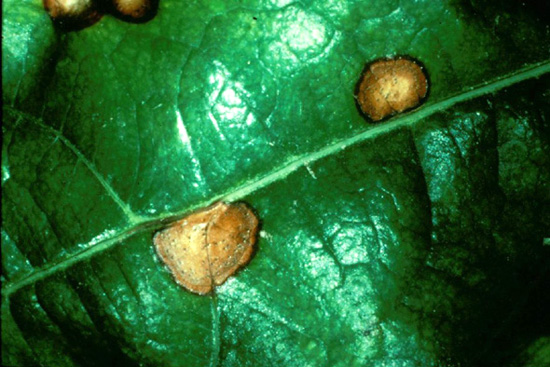Issue 5, May 21, 2010
Ivy Leaf Spots
There are commonly two types of leaf diseases on English ivy used as ground covers in landscape beds. We see them both fairly frequently in Illinois. The first is caused by one or more fungi and the other is caused by a bacterium.
The fungal leaf spot has been present through winter and spring. New foliage is not yet infected, so you can take measures to protect it where visual impact is important. The fungal leaf spot is generally brown in the center with a dark border. Sometimes concentric rings give the spots a target appearance. Spots are scattered over the leaves.
Several fungi may be involved, with Colletotrichum being the most common in Illinois. Fungi form fruiting bodies in the lesions, as seen in the first image. These are more readily seen after rain. They will also appear after incubation over night.

Bacterial leaf spot does not produce fruiting bodies. Circular, dark green, and water-soaked (oily looking) areas on ivy leaves are typical of bacterial infection. Spots may enlarge and have a red/brown to black center with a water-soaked margin. Sometimes a yellow halo appears around the lesion. Stems may be infected as well. The second image shows the bacterial disease on ivy.

Look at fresh tissue you to distinguish these diseases and to choose the proper control. Now is the time to spray to protect new growth from infection. Chemical options are provided in the 2010 Illinois Commercial Landscape and Turfgrass Pest Management Handbook as well as the Home, Yard, and Garden Pest Guide. Both pathogen groups are spread in splashing water. To avoid spreading the pathogen within the ivy planting, do not work with wet plants.
For more information about these diseases, refer to Report on Plant Disease (RPD), no. 652, Leaf Spot Diseases of English Ivy (Adobe PDF). --Nancy Pataky
Author:
Nancy Pataky